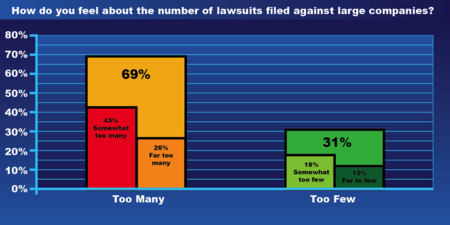By Dr. Ken Broda Bahm:

News: Americans still don’t love lawsuits. According to polling conducted in August by Luce Research for the American Tort Reform Association and the group, Sick of Lawsuits, “Americans firmly believe that lawsuit abuse is a problem in our country. They see too many lawsuits and believe that the number of lawsuits filed have hurt the economy and jobs.” As we and others (Hoffman, 2011) have written previously, there are good reasons to doubt the degree of factual support for the perception of an expanding tidal wave of frivolous jury verdicts that these anti-lawsuit attitudes would presumably be based on. At the same time, the perception is important for both plaintiffs and defendants because it serves as a critical backdrop to jurors’ initial perceptions of a civil case.
While anti-lawsuit attitudes are definitely real, the recent survey should be taken with a grain or two of salt. For the sponsors of the polling, the purpose is simple: to pass additional tort reform at the state and federal level. For litigators, however, the takeaway is a little more nuanced. Understanding and adapting to attitudes about lawsuits requires some specific attention to the survey itself — what it asked and how — and requires asking your own questions in order to measure and interpret this attitude as it affects your own case.
Let’s start by taking a closer look at the survey itself and its conclusions. The telephone poll of 1,013 voters was conducted by a reputable survey company and boasts a high confidence interval. Among the more striking findings are the following:
- 89 percent see lawsuit abuse as a problem.
- 60 percent agree that the number of lawsuits filed against businesses has hurt the U.S. economy.
- 83 percent believe that the current liability lawsuit system needs improvement.
- Personal injury lawyers receive the highest share of the blame (36 percent).
If we accept those attitudes on face, close to nine in ten jurors walking into a civil case would be pro-defense by default. While the attitudinal skew can often be high, most experienced litigators understand that it isn’t quite that high.
1. Account for the Way the Questions Were Asked
A survey response is only as good as the question that elicited it, so lets look a little more closely at the questions that ATRA and SOL asked. Under the heading “Nearly all voters say lawsuit abuse is a problem,” we see that 34 percent say “major” problem, 35 percent say “big” problem, 21 percent say “minor” problem, and only 5 percent say “not a problem at all.” The problem there is that three out of four of the response options presume that it is a problem and just vary the degree. That is a little like Steven Colbert’s question to numerous guests, “George Bush: great president, or the greatest president?” And even on the one option they give for respondents to say it isn’t a problem, the language further minimizes the response by adding “not a problem at all.” It is a question designed by an advocacy group because it structurally works to get the greatest percentage to say lawsuit abuse is a problem.
The survey also reports a high level of agreement (ranging from 90 to 72 percent) with a number of statements like, “Lawsuits and legal settlements should seek to compensate people for their actual losses and not make them ridiculously rich.” Setting aside the language and assumptions there, the problem with agree/disagree questions is something called “acquiescence bias” which is the high tendency for individuals to agree rather than disagree with a statement. For that reason, most researchers will vary the type of statement so that, for example, half are statements against lawsuits and half are statements for them. In this survey, however, every one of the statements is an anti-lawsuit or pro-tort reform statement similar to the one above. In so doing, the survey is priming respondents to see lawsuit abuse as a problem and counting the entire acquiescence bias error in their own column.
Seeking to identify who is to blame for the problems, the report indicates that “personal injury lawyers” carry the greatest responsibility with 36 percent of respondents pointing to them, with a few other factors (laws, legislators, insurance companies, judges, juries) taking a smaller share of the responsibility. Based on the report, it appears survey respondents were given that list and asked who was most responsible. But there is one party missing from that list: defendants. It is like asking, “Who is to blame for all of these allegations of harm?” and leaving “those alleged to have caused the harm” off the list.
Now, my point here is not to pick a side between plaintiffs and defendants – we happily work for both in all facets of civil litigation. But our bias is in favor of accurate research. Whether you are a plaintiff or a defendant assessing the climate for your case, you shouldn’t assume that this and similar motivated surveys are giving you the full and accurate picture.
2. Ask Your Own Questions
The best way to do that is to ask your own questions. That is what we’ve done for a number of years, and our most recent survey (July, 2011, N=406) shows a preponderance of respondents believing that there are too many lawsuits, though not nearly to the same degree.
While our survey was earlier and does not have a comparable sample size, it does have the advantage of a more balanced question. In this case, the fact that fully 31 percent of respondents are saying that there are “too few” lawsuits (only 8 percent responded similarly in the ATRA/SOL survey) is something that defendants would want to know.
Beyond asking in a survey, litigators also need practical and strategic ways to ask about this bias in court. This is where a knowledge of where the majority is likely to fall will be helpful in identifying your strikes without shining a light on your most favorable jurors. Defendants, for example, might ask “Who feels there are too many lawsuits?” for the priming effect of seeing a majority raise their hands, but then target those who say “far too few” for their strikes. A plaintiff asking the same question, however, is just telling the defense who to strike. A better question for creating a strikeable minority for the plaintiff would be to ask something like this:
We all know that many believe that there are too many lawsuits in this country. But who here is opposed to lawsuits to such a degree that you probably would not sue, even if you were injured through someone else’s fault?
3. Consider Anti-Lawsuit Attitudes Through the Prism of Today’s Economy
Attitudes don’t exist in a vacuum, but interact strongly with context and experience. Consistent with the economic times, the survey also looks at the role of lawsuits in hurting the U.S. economy, and predictably, a majority believe that lawsuits have hurt the economy and jobs. Interestingly, it is on this question that the ATRA/SOL survey reports the greatest non-acquiescence, with four out of ten either saying “no” lawsuits haven’t hurt the U.S. economy (31 percent) or reporting that they’re unsure (9 percent). The 31 percent likely have some other cause in mind and the survey does not ask participants to compare lawsuits to other perceived contributors to our economic woes.
In one example of the interactive nature of attitudes, however, despite this finding that people believe lawsuits harm the economy, those who are most harmed are actually the least likely to blame lawsuits. Our own research has shown that those who are “very concerned” about their ability to pay their current bills tend to be the most anti-corporate respondents, and for that reason are more likely to support lawsuits against them. This is one example of the ways that litigators need to look beyond the simplistic “too many lawsuits” attitude and consider the broader picture. In today’s climate, learning about a potential jurors’ economic circumstances may be more important than hearing what they think about lawsuits.
The bottom line is, as much as we’re trying to limit sodium intake, at least a few grains of salt need to be taken when interpreting the survey data that is circulated by groups supporting a legislative agenda. Instead of taking these results as established fact, litigators should be doing their own assessments within the specific venue and venire in order to discover the unique combinations of attitude and experience that have the greatest bearing on the individual case.
______
Other Posts on Measuring Attitudes:
- Measure Your Potential Juror’s Anti-Corporate Bias: Get the Scale Here
- The Products Survey (Part III): Safety Test Your Jurors
- Yes, Virginia, There is a CSI Effect: Account for It in Your Science Case
______
Photo Credit: K.Broda Bahm
